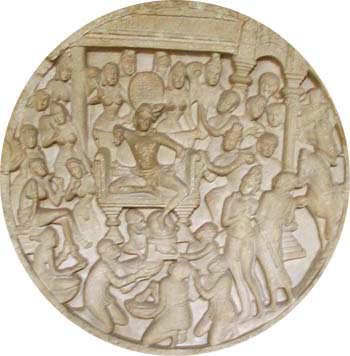| Amaravati Sculptures (2nd Century BC to 2nd Century AD) The collection of the
early Buddhist sculptures includes the large group of sculptures received from the ruined
stupa at Amaravati in the Krishna valley in the Andhra country
wherein an excavation was conducted in the 1801 and later.Colonel.Colin Mackenzie of the
Trigonometrical Survey of India first heard of the mound in the area and visited the site and
found it was very interesting as it had specimens of early Christian era art. Then he drew
sketches of the site and left. Later in 1830 some of the sculptured slabs were brought to Masulipatnam
to beautify a square named after Robertson, the District Collector. During the course of his
visit to this place in 1835, Sir Frederick Adam, Governor of Madras, saw the slabs and ordered
that these to be sent to Madras for preservation in the Museum of the Madras Literary Society.
Dr.Balfour, soon after taking charge of the Madras Central Museum, began his efforts in
getting the aforesaid slabs and the first batch arrived here in 1856. Other batches of
sculptures were secured during Dr.Bidie's time and they were set up in their present location
in the Museum. On the question of the arrangement and display of these Amaravati
marbles in the Madras Museum in 1884-85, Dr.Bidie had to cross swords with no less a person
than Burgess of the Archaeological Department of the Government of India, but while the
distinguished archaeologist demonstrated more of dogmatism and heat, Dr.Bidie showed himself
that he was the master of the situation and what he did was only practicable way of dealing
with the sculptures. The reader should visualise the great Amaravati Stupa, a poetry
in marble, the ninety feet high marble-encased cupola surmounted by big stone umbrellas, the
series of tall slender marble columns on the platforms marking four cardinal points, the four
festooned gateways flanked by lion-topped columns and the fourteen feet high, sculptured
railing round the stupa, all of which, together, must have been a sight of glory! There are
four periods of sculptures in the Amaravati group of sculptures.
Period I - 200 to 100
BC; Period II - 100 AD; Period III - 150 AD and Period IV - 200 to 250 AD. |
| . Cross-bar with Sculptured Medallion (Period III)
The sculpture depicts the story of the presents of king Bandhuma.
King Bandhuma of Bandhumati received two presents
consisting of a costly wreath and a precious sandal-wood. He distributed them to his two
daughters. They in the turn, offered them to the Buddha, in his previous incarnation Vipassi.
As a result of this, in their later rebirth, the elder of the two prinesss was born as Mayadevi,
the mother of Gauthama, and the younger attained sainthood.
In the sculpture the king is shown on a throne, attended by chauri-bearers.
To his right are his two daugthers, the first seated and attended by maid servants and the
second standing near the throne. Below the king's throne are pages offering the presents. Some
men are shown on the right coming through an arched gate adjoining the palace. A horse and an
elephant are also seen.
The king's throne with rearing lions, the pages in tunic with curly
hair, the coiffure of the maid servant at the feet of the seated princess and the archway are
noteworthy.
|

|